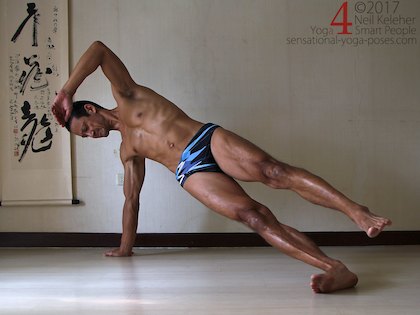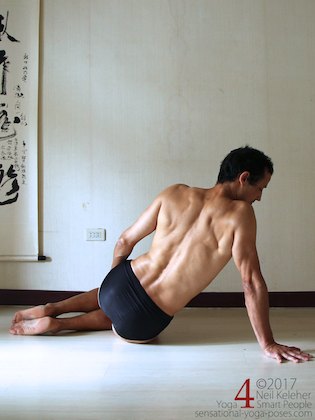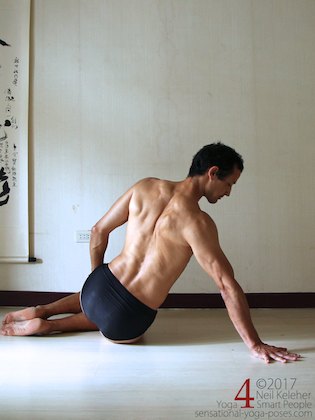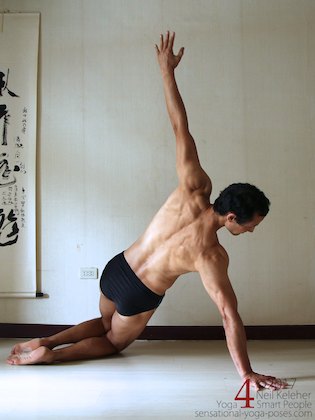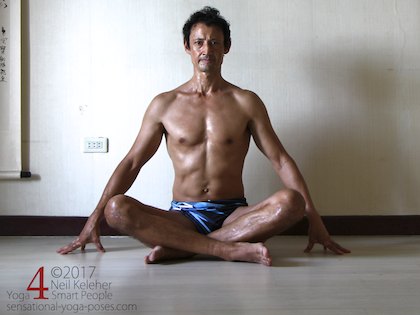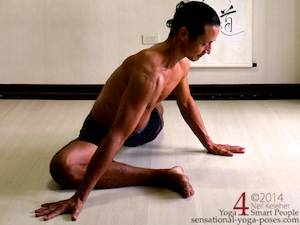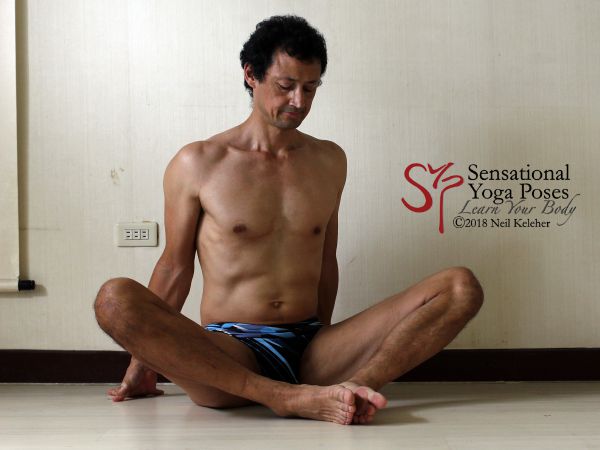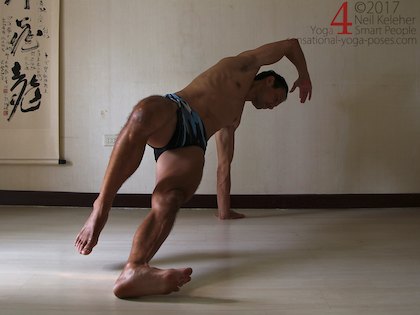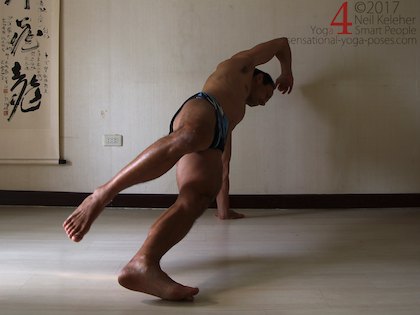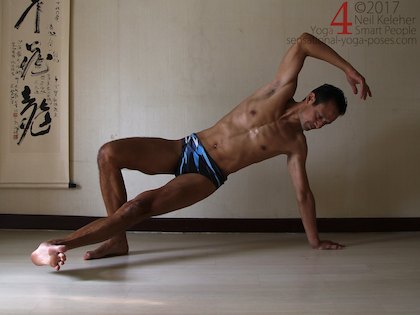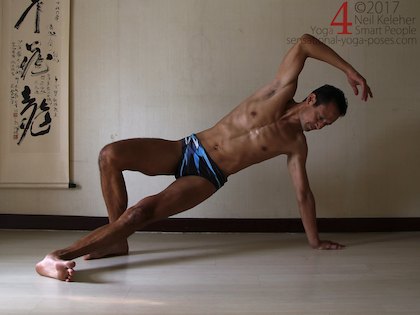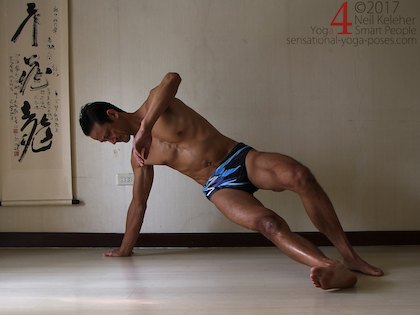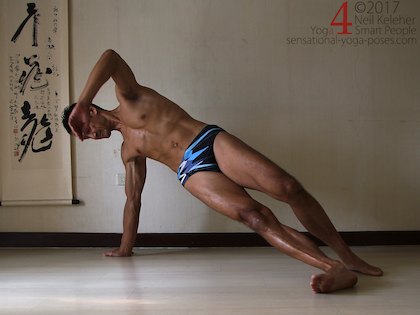Balancing In Side Plank Yoga Pose (Vasisthasana)
A step-by-step tutorial
When teaching beginners how to balance in side plank yoga pose, I like to use a step-by-step approach.
Often times I'll do simple scapular awareness exercises prior to plank to get them used to feeling their shoulder blades moving relative to their ribcage.
The next exercise is then to have them move their ribcage relative to their arm with one hand on the floor.
Hip Action for Side Plank
The next step is to learn how to use the hip. With knees bent and the bottom knee on the floor, this can be a simple case of pressing the bottom knee down so that the hips lift off of the floor.
The trick then is to first lift the ribcage using the shoulder. Then to keep the shoulder active as the hips are lifted.
Foot Pressing
An action that I often teach my students as a preparation for balancing in side plank pose is pressing the outer edge of the foot into the floor while sitting cross legged. This same action can be done in pigeon pose, focusing on the front foot, and also in bound angle, with feet far from the pelvis and with feet close.
Cross Legged Foot Press
Sitting cross legged, for students with knee problems I suggest just focusing on the front foot, pressing the outside edge of the foot into the floor using leg muscle strength. In this case the upper body should not move while pressing the foot down.
It can feel like you are trying to press the blade of your foot down through the floor.
If your knee hurts doing this action in this pose, then skip it.
When you initiate the foot press keep your knee from moving upwards or downwards.
Practice pressing and releasing a few times, then switch legs and repeat.
Pigeon Foot press
If you have knees that are susceptible to pain then this pose may be easier on them than the previous pose.
For this version of pigeon, have your front leg hip on the floor. Position your front shin so that it is parallel to the front of your mat. (In the pictures I'm using an imaginary mat).
You can use one or both arms to support your upper body. Make your front foot rigid, particularly the blade of your foot, and press it into the floor without allowing your upper body to shift. Relax and repeat. See if you can feel the outside of your heel pressing into the floor. Also notice the outer edge of your forefoot pressing into the floor.
Bound Angle Foot press
If you have knees that are susceptible to pain then this pose may be easier with the feet further forwards.
Even without knee problems, try the foot press with feet further forwards first, and then with feet closer to the pelvis. In both cases feet are together with knees bent to the sides. Sit upright with your hands on the floor behind your back.
You can use your hands to help press your body upright.
Keeping your knees and upper body still you can focus on pressing one foot and releasing it. Repeat a few times then try it with the other foot. Then do both feet at the same time.
You may find that it is easier to press the outer edges of your feet down against the floor with the inner edges of your feet close together.
Feeling the Foot Press
The idea of all of these "foot pressing" poses is to feel the blade of your foot or feet pressing down into the floor. You may also have noticed the sensation of muscle activation in your outer thigh or buttock. These are the sensations you'll try and find while trying to balance in side plank pose.
To make balancing in side plank easier, you need your foot to be strong and stable versus relaxed and floppy. This is a large part of what will make balancing easier in this pose.
With the foot and ankle active and strong, next press the outside edge of that foot down into the floor. It may take you a couple of goes to get this.
When pressing the blade of your foot down try to press it down so that the front part has the same amount of pressure as the back part of the foot.
To get pressure even all along the outside edge of your foot, move your hips forwards or backwards. What you should find is that if you move your hips forwards, the front of the foot will press down more. If you move your hips backwards the back of the foot will press down more.
In the pictures below I've doing side plank with the elbow straight and hand (and foot) on the floor. But notice:
- with my hips back the front of my foot lifts.
- With my hips forwards the back of my foot lifts.
When moving your hips forwards or backwards, make the movement very very small. You'll only need to move your hips a short distance forwards or backwards to change the way that your foot presses into the floor.
Once you find the position where foot pressure is even, then work at preventing your hips from moving backwards or forwards.
Now if up until this point you were practicing on your forearm, now try it with your elbow straight.
Getting your Hips Up in Side Plank
Now if you new to Side plank, one of the challenges you may have is getting your hips up with the knee (and elbow) straight.
One way around this is to use your top leg to help as in the pictures below.
In the first picture I'm using my top leg to lift my hips. In the second picture my bottom foot is on the floor so that I can use it to keep my hips lifted.
For this variation you might find it easier if you start with your top foot on the floor behind your bottom leg.
Use your top leg or both legs to lift your pelvis. From here:
- Make your bottom foot and ankle strong and active.
- Place the edge of the bottom foot on the floor and press it down.
- Press it down with enough pressure that your leg feels strong.
- Then slowly shift your hips forwards far enough that the front and back of the outer edge of your bottom foot press down with equal pressure.
You may find that your top leg relaxes, in which case you can then lift that foot. If you can't then first, make sure that you have shifted your weight far enough forwards, then make sure that you are pressing the bottom foot strongly into the floor.
Note, so that you stay balanced in side plank when lifting the top leg, stay aware of the way the outer edge of the bottom of your foot presses into the floor.
Further Learning
For more on learning to stabilize your shoulder blades read scapular awareness.
For more on shoulder awareness, flexibility and control read the ebook shoulder yoga.
Published: 2011 03 12
Updated: 2021 02 09
